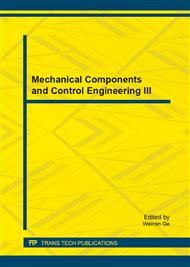[1]
Wen Ye, Hongda Fan, Aihong Zhu, et al. Mission planning for Unmanned Aerial Vehicles [M]. Beijing: National Defense Industry Press, 2011. 171 – 172. (In Chinese).
Google Scholar
[2]
Borrelli F, Subramanian D, Raghunathan U A, et al. MILP and NLP Techniques for Centralized Trajectory Planning of Multiple Unmanned Air Vehicles [C]. In Proceedings of the 2006 American Control Conference. 2006, 6: 5763–5768.
DOI: 10.1109/acc.2006.1657644
Google Scholar
[3]
Shaomei Song, Ke Zhang, Shiyi Guan. A Trajectory Planning Method Based on Hierarchy Decomposition Strategy for Coordination of Multiple Unmanned Air Vehicles. [J]. Tactical Missile Technology, 2004, (1): 44–48. (In Chinese).
Google Scholar
[4]
Li Yang. Research on Path Planning for Unmanned Aerial Vehicle [D]. Nanjing: Nanjing University of Aeronautics and Astronautics, 2009. (In Chinese).
Google Scholar
[5]
Richards A, How J P. Decentralized Model Predictive Control of Cooperating UAVs [C]. In Proceedings of the 43rd IEEE Conference on Control and Decision. 2004, 4: 4286–4291.
DOI: 10.1109/cdc.2004.1429425
Google Scholar
[6]
La Velle S M. Rapidly-Exploring Random Trees: A New Tool for Path Planning [R]. Computer Science Department, Iowa State University, (1998).
Google Scholar
[7]
Yong BAO, Xiaowei FU, Xiaoguang GAO. A Method of Cooperative Path Planning of Multiple UAVs on Potential Field Theory [J]. Fire Control& Command Control, 2012, 37(3): 10-12. (In Chinese).
Google Scholar
[8]
Feng Zhang, Zhe Sun, Meiju Liu. Formation Control based on the method of artificial potential and the leader-follower for multiple mobile robots [J]. Journal of Shenyang Jianzhu University, 2010, 26(4): 803–807. (In Chinese).
Google Scholar
[9]
Campa G, Napolitano M R, Brad S, et al. Design of Control Laws for Maneuvered Formation Flight [C]. Proceedings of the American Control Conference. Boston, USA: IEEE, 2004: 2344–2349.
DOI: 10.23919/acc.2004.1383814
Google Scholar
[10]
Xiaoli Li, Jin Xie. An improved artificial potential field method used in multiple robots collision planning [J]. Computer engineering and Applications, 2005, 17: 56–58. (In Chinese).
Google Scholar
[11]
Desai J P. A graph theoretic approach for modeling mobile robot team formations [J]. J of Robotic Systems, 2002, 19(11): 511–525.
DOI: 10.1002/rob.10057
Google Scholar
[12]
Pereira G A S, Das A K, Kumar V, et al. Formation control with configuration space constraints [C]. Proc of the IEEE/RJS Int Confon Intelligent Robots and Systems. Las Vegas, (2003).
Google Scholar
[13]
Olfati-Saber R, Murray R M. Graph rigidity and distributed formation stabilization of multi-vehicle systems [C]. Las Vegas: 41st Conference on Decision and Control, (2002).
DOI: 10.1109/cdc.2002.1184307
Google Scholar


